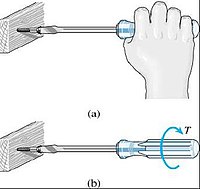
Back قابلية الاستخدام Arabic Ползваемост Bulgarian Usabilitat Catalan Použitelnost Czech Brugervenlighed Danish Gebrauchstauglichkeit (Produkt) German Ευχρηστία Greek Usabilidad Spanish Kasutatavus Estonian Erabilgarritasun Basque

Usability can be described as the capacity of a system to provide a condition for its users to perform the tasks safely, effectively, and efficiently while enjoying the experience.[1] In software engineering, usability is the degree to which a software can be used by specified consumers to achieve quantified objectives with effectiveness, efficiency, and satisfaction in a quantified context of use.[2]
The object of use can be a software application, website, book, tool, machine, process, vehicle, or anything a human interacts with. A usability study may be conducted as a primary job function by a usability analyst or as a secondary job function by designers, technical writers, marketing personnel, and others. It is widely used in consumer electronics, communication, and knowledge transfer objects (such as a cookbook, a document or online help) and mechanical objects such as a door handle or a hammer.
Usability includes methods of measuring usability, such as needs analysis[3] and the study of the principles behind an object's perceived efficiency or elegance. In human-computer interaction and computer science, usability studies the elegance and clarity with which the interaction with a computer program or a web site (web usability) is designed. Usability considers user satisfaction and utility as quality components, and aims to improve user experience through iterative design.[4]
- ^ Lee, Ju Yeon; Kim, Ju Young; You, Seung Ju; Kim, You Soo; Koo, Hye Yeon; Kim, Jeong Hyun; Kim, Sohye; Park, Jung Ha; Han, Jong Soo; Kil, Siye; Kim, Hyerim (2019-09-30). "Development and Usability of a Life-Logging Behavior Monitoring Application for Obese Patients". Journal of Obesity & Metabolic Syndrome. 28 (3): 194–202. doi:10.7570/jomes.2019.28.3.194. ISSN 2508-6235. PMC 6774444. PMID 31583384.
- ^ Ergonomic Requirements for Office Work with Visual Display Terminals, ISO 9241–11, ISO, Geneva, 1998.
- ^ Smith, K Tara (2011). "Needs Analysis: Or, How Do You Capture, Represent, and Validate User Requirements in a Formal Manner/Notation before Design". In Karwowski, W.; Soares, M.M.; Stanton, N.A. (eds.). Human Factors and Ergonomics in Consumer Product Design: Methods and Techniques (Handbook of Human Factors in Consumer Product Design). CRC Press.
- ^ Nielsen, Jakob (4 January 2012). "Usability 101: Introduction to Usability". Nielsen Norman Group. Archived from the original on 1 September 2016. Retrieved 7 August 2016.